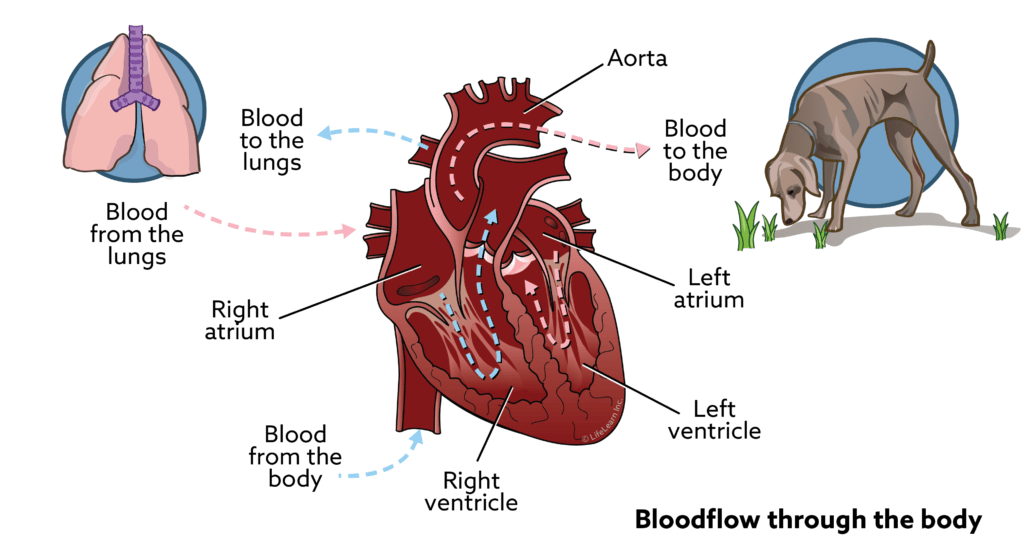Qual è il dotto arteriosus?
Il Ductus arteriosus è un'apertura tra l'aorta e l'arteria polmonare, i due vasi sanguigni principali che portano dal cuore. È normalmente presente durante lo sviluppo fetale.

Qual è il suo scopo?
Prima della nascita, il feto in via di sviluppo riceve tutto il suo ossigeno attraverso la placenta e i polmoni in via di sviluppo sono sgonfiati. Come parte della circolazione fetale, il Ductus arteriosus consente alla maggior parte del sangue circolante di bypassare i polmoni. Pertanto, mentre il feto è nell'utero, il ductus arteriosus è normalmente aperto o "brevetto".
Quando il cucciolo di neonato prende il suo primo respiro, il Ductus viene stimolato per chiudere. La chiusura del Ductus arteriosus garantisce che il sangue circolerà attraverso i polmoni gonfiati e diventa ossigenato.

Che cos'è il ductus arteriosus di brevetto?
Il ductus arteriosus di brevetto (PDA) è un difetto cardiaco che si verifica quando il Ductus arteriosus non si chiude alla nascita.
Cosa succede se il Ductus arteriosus non si chiude alla nascita?
Nel cuore normale, il sangue scorre dal corpo nel lato destro del cuore, quindi viene pompata attraverso l'arteria polmonare nei polmoni per essere ossigenato. Dai polmoni, scorre attraverso la vena polmonare nel lato sinistro del cuore. Il lato sinistro del cuore quindi pompa il sangue attraverso l'aorta, distribuendo sangue ricco di ossigeno al corpo. I muscoli nel lato sinistro del cuore sono normalmente più spessi e più forti di quelli nel lato destro del cuore. La pressione all'interno del lato sinistro del cuore e l'aorta è superiore alla pressione sul lato destro e all'arteria polmonare e alle vene. Questo perché è più difficile pompare il sangue a tutto il corpo che pompare il sangue attraverso i polmoni.

Se il ductus arteriosus non si chiude correttamente dopo la nascita, quella differenza di pressione tra l'arteria polmonare e l'aorta significa che il sangue prenderà il percorso di minor resistenza e flusso dall'aorta attraverso il ductus arteriosus di brevetto e nell'arteria polmonare. L'arteria polmonare quindi inutilmente ricircola questo sangue ossigenato ai polmoni. Poiché ora meno sangue viene pompato nella circolazione principale attraverso l'aorta, il lato sinistro del cuore è costretto a lavorare di più per soddisfare le esigenze del corpo.
La dimensione del difetto del Ductus Arteriosus di brevetto determinerà quanto il cuore deve funzionare più difficile. Se il difetto è piccolo, il lato sinistro del cuore diventa leggermente ingrandito (lieve ipertrofia ventricolare sinistra). Se il difetto è di medie dimensioni, il lato sinistro del cuore diventa moderatamente ingrandito. Man mano che il cuore si allarga, è costretto a lavorare di più e alla fine questo aumento del lavoro può portare a insufficienza cardiaca congestizia (vedere il volantino su "insufficienza cardiaca congestizia nei cani").
In alcuni casi, quando il PDA è grande, una quantità significativa di sangue si sposta nei polmoni, costringendo l'arteria polmonare, la vena polmonare e il lato destro del cuore per diventare più spesso (chiamato ipertrofia ventricolare destra) per affrontare il carico in eccesso di sangue. Questo ispessimento porta all'ipertensione polmonare (elevata pressione sanguigna nei polmoni) e alla fine può causare la direzione dello shunt.
Quali sono i segni di un PDA?
Un cane che ha un piccolo difetto PDA potrebbe non mostrare evidenti segni di malattia. Man mano che il PDA aumenta di dimensioni, più sangue verrà suscitato attraverso di esso, causando segni più significativi. Questi possono includere difficoltà a respirare, un forte mormorio a cuore, impulsi anormali e intolleranza all'esercizio. Un cucciolo con un PDA può dormire più del solito, può essere stentato nella crescita o forse più sottile della media.
Mentre il sangue continua a sbirciare attraverso il PDA, causerà cambiamenti irreversibili nel muscolo cardiaco e alla fine potrebbe portare a insufficienza cardiaca congestizia. Se il PDA è abbastanza significativo da causare insufficienza cardiaca congestizia, i segni possono anche includere un'aritmia cardiaca (battiti cardiaci anormali), un aumento dei suoni polmonari quando ascoltato con uno stetoscopio e l'accumulo di liquido nei polmoni e/o nell'addome.
Quando lo shunt è molto grande, la pressione nella circolazione polmonare può continuare ad aumentare fino a quando non supera la pressione nell'aorta. Se ciò accade, lo shunt può invertire, in modo che il sangue torni dalle scorciatoie del corpo attraverso l'aorta prima di attraversare i polmoni per ricevere ossigeno. Se il cane sviluppa questo "PDA inverso", il mormorio cardiaco scomparirà e i segni diventeranno gravi e debilitanti, compresi i battiti cardiaci anormali, la cianosi (blua) dei cuscinetti delle zampe posteriori, il crollo delle zampe posteriori quando il cane si esercita e la debolezza o la letargia.
Qual è il dotto arteriosus?
Il Ductus arteriosus è un'apertura tra l'aorta e l'arteria polmonare, i due vasi sanguigni principali che portano dal cuore. È normalmente presente durante lo sviluppo fetale.
Ci sono razze che sono colpite più spesso di altre?
Il ductus arteriosus di brevetto è la malattia congenita più comune nei cani e più comune nelle donne cani. Sebbene qualsiasi razza per cani possa essere influenzata da questo difetto cardiaco, il PDA sembra avere una componente ereditabile nelle razze di cani più piccole. Le razze che hanno riferito hanno più problemi con questo difetto includono American Cocker Spaniel, Bichon Frude, Chihuahua, Collie, English Springer Spaniel, Pastore tedesco, Setter irlandese, Keeshonden, Kerry Blue Terrier, Labrador Retriever, Maltese, Miniatura e Poodle giocattolo, Newfoundland, Pomeran, Shetland Terlier.
Questo difetto sembra funzionare nelle famiglie. I cani colpiti non devono essere allevati, anche se la condizione viene trattata con successo.
Come viene diagnosticato il PDA?
Un PDA viene solitamente diagnosticato quando il veterinario sente un mormorio cardiaco continuo durante un esame fisico di routine del tuo cucciolo. Un mormorio continuo è presente continuamente durante l'intero ciclo del cuore. Viene spesso descritto come un "mormorio macchinario" o un "mormorio per la lavatrice" perché sembra che l'acqua venga agitata attraverso il ciclo di lavaggio. Il mormorio sarà classificato su una scala da 1 a 6, con il numero più elevato più grave. Se il mormorio è pronunciato, potresti essere in grado di sentire un ronzio quando tocchi il petto del cucciolo. Questo ronzio si chiama brivido.
Il tuo veterinario consiglierà i raggi X del torace (radiografie) per valutare il cuore e i polmoni e un elettrocardiogramma (ECG) per valutare il ritmo cardiaco. Gli esami del sangue mostreranno se altri organi sono influenzati dal flusso sanguigno anormale o se ci sono elevati valori di globuli rossi. I globuli rossi portano ossigeno e il corpo tenta di soddisfare le sue maggiori esigenze di ossigeno producendo più globuli rossi.
L'ecocardiografia, o ultrasuoni cardiaci, sarà necessaria per diagnosticare definitivamente un PDA. L'ecografia esaminerà un'immagine in movimento del cuore per valutare il grado di ingrandimento delle sue pareti e l'efficienza del suo pompaggio. L'ecocardiografia Doppler, che valuta la direzione e la velocità del flusso sanguigno, verrà utilizzata per aiutare a individuare la posizione e le dimensioni dello shunt e per determinare la quantità di turbolenza associata allo shunt.
I segni potrebbero essere causati da qualcos'altro?
Altri difetti cardiaci complessi possono anche causare un mormorio cardiaco continuo. L'ecocardiografia di solito differenzia il tipo di difetto, contribuendo a determinare le opzioni di trattamento appropriate.
Qual è il trattamento per un PDA?
L'obiettivo del trattamento per un PDA a flusso in avanti è fermare il sangue che scorre attraverso lo shunt. Il tuo veterinario ti indirizzerà a un chirurgo cardiovascolare veterinario, che determinerà il trattamento ottimale per il tuo cane. In alcuni casi, il Ductus sarà legato durante la chirurgia cardiaca.
In altri casi, un trattamento chirurgico meno invasivo può essere un'opzione. La procedura meno invasiva prevede l'occlusione (blocco) del ductus arteriosus con una bobina transarteriale o un dispositivo occluder duttale, che viene posizionato usando cateterizzazione cardiaca.
La riparazione chirurgica dovrebbe essere eseguita il prima possibile. Più è ritardata l'intervento chirurgico, più è probabile che si verifichi danni irreversibili cardiaci. Se il cane mostra segni di insufficienza cardiaca, sarà necessaria la stabilizzazione pre-chirurgica.
Non esiste un trattamento chirurgico per un PDA inverso. Il trattamento medico aiuterà a gestire i sintomi, ma una cura non è possibile per i cani con un PDA inverso e sarà inevitabilmente fatale.
Qual è il tasso di successo per il trattamento chirurgico del PDA?
A condizione che la condizione venga trattata prima che si sviluppi l'insufficienza cardiaca, il tasso di successo associato alla chiusura chirurgica è molto elevata e la prognosi per una vita normale dopo l'intervento chirurgico è eccellente.
Se è presente un danno cardiaco irreversibile prima dell'intervento, il cane può richiedere farmaci cardiaci in futuro.
Qual è il tasso di successo per la gestione medica di un PDA inverso?
Se i segni della malattia possono essere controllati con i farmaci, il cane può vivere comodamente per diversi anni.
Qual è la prognosi per gli animali domestici con PDA?
La diagnosi e il trattamento rapidi e appropriati di questo disturbo cardiaco ereditario congenito sono associati a un'eccellente prognosi a lungo termine. Sia le tecniche transcatetere chirurgiche e minimamente invasive standard possono trattare con successo la condizione fintanto che non è progredita a un PDA inverso.

| Biscotto | Durata | Descrizione |
|---|---|---|
| cookielawinfo-checkbox-analytics | 11 mesi | This cookie is set by GDPR Cookie Consent plugin. The cookie is used to store the user consent for the cookies in the category "Analytics". |
| cookielawinfo-checkbox-funzionale | 11 mesi | The cookie is set by GDPR cookie consent to record the user consent for the cookies in the category "Functional". |
| cookielawinfo-checkbox-necessario | 11 mesi | This cookie is set by GDPR Cookie Consent plugin. The cookies is used to store the user consent for the cookies in the category "Necessary". |
| cookielawinfo-checkbox-altri | 11 mesi | This cookie is set by GDPR Cookie Consent plugin. The cookie is used to store the user consent for the cookies in the category "Other. |
| cookielawinfo-checkbox-performance | 11 mesi | This cookie is set by GDPR Cookie Consent plugin. The cookie is used to store the user consent for the cookies in the category "Performance". |
| visti_cookie_policy | 11 mesi | Il cookie viene impostato dal plug-in GDPR Cookie Consent e viene utilizzato per memorizzare se l'utente ha acconsentito o meno all'uso dei cookie. Non memorizza alcun dato personale. |